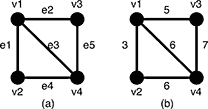poj 3522 Slim Span (最小生成树kruskal)
http://poj.org/problem?id=3522
| Time Limit: 5000MS | Memory Limit: 65536K | |
| Total Submissions: 5666 | Accepted: 2965 |
Description
Given an undirected weighted graph G, you should find one of spanning trees specified as follows.
The graph G is an ordered pair (V, E), where V is a set of vertices {v1, v2, …, vn} and E is a set of undirected edges {e1, e2, …, em}. Each edge e ∈ E has its weight w(e).
A spanning tree T is a tree (a connected subgraph without cycles) which connects all the n vertices with n − 1 edges. The slimness of a spanning tree T is defined as the difference between the largest weight and the smallest weight among the n − 1 edges of T.
 Figure 5: A graph G and the weights of the edges
Figure 5: A graph G and the weights of the edgesFor example, a graph G in Figure 5(a) has four vertices {v1, v2, v3, v4} and five undirected edges {e1, e2, e3, e4, e5}. The weights of the edges are w(e1) = 3, w(e2) = 5, w(e3) = 6, w(e4) = 6, w(e5) = 7 as shown in Figure 5(b).
 Figure 6: Examples of the spanning trees of G
Figure 6: Examples of the spanning trees of GThere are several spanning trees for G. Four of them are depicted in Figure 6(a)~(d). The spanning tree Ta in Figure 6(a) has three edges whose weights are 3, 6 and 7. The largest weight is 7 and the smallest weight is 3 so that the slimness of the tree Ta is 4. The slimnesses of spanning trees Tb, Tc and Td shown in Figure 6(b), (c) and (d) are 3, 2 and 1, respectively. You can easily see the slimness of any other spanning tree is greater than or equal to 1, thus the spanning tree Td in Figure 6(d) is one of the slimmest spanning trees whose slimness is 1.
Your job is to write a program that computes the smallest slimness.
Input
The input consists of multiple datasets, followed by a line containing two zeros separated by a space. Each dataset has the following format.
| n | m | |
| a1 | b1 | w1 |
| ⋮ | ||
| am | bm | wm |
Every input item in a dataset is a non-negative integer. Items in a line are separated by a space. n is the number of the vertices and m the number of the edges. You can assume 2 ≤ n ≤ 100 and 0 ≤ m ≤ n(n − 1)/2. ak andbk (k = 1, …, m) are positive integers less than or equal to n, which represent the two vertices vak and vbk connected by the kth edge ek. wk is a positive integer less than or equal to 10000, which indicates the weight ofek. You can assume that the graph G = (V, E) is simple, that is, there are no self-loops (that connect the same vertex) nor parallel edges (that are two or more edges whose both ends are the same two vertices).
Output
For each dataset, if the graph has spanning trees, the smallest slimness among them should be printed. Otherwise, −1 should be printed. An output should not contain extra characters.
Sample Input
4 5 1 2 3 1 3 5 1 4 6 2 4 6 3 4 7 4 6 1 2 10 1 3 100 1 4 90 2 3 20 2 4 80 3 4 40 2 1 1 2 1 3 0 3 1 1 2 1 3 3 1 2 2 2 3 5 1 3 6 5 10 1 2 110 1 3 120 1 4 130 1 5 120 2 3 110 2 4 120 2 5 130 3 4 120 3 5 110 4 5 120 5 10 1 2 9384 1 3 887 1 4 2778 1 5 6916 2 3 7794 2 4 8336 2 5 5387 3 4 493 3 5 6650 4 5 1422 5 8 1 2 1 2 3 100 3 4 100 4 5 100 1 5 50 2 5 50 3 5 50 4 1 150 0 0
Sample Output
1 20 0 -1 -1 1 0 1686 50
Source
换个角度想就是用n-1条(n个点)数值相差不多的边,组成一棵生成树。 在生成树的prim和kruskal两个算法中很容易就会觉得kruskal的贪心思想会更加适合这道题。 kruskal算法一开始会对边进行排序,然后枚举最小的边。
1 /** 2 Judge Status:Accepted Memory:756K 3 Time:157MS Language:G++ 4 Code Lenght:1613B Author:cj 5 */ 6 7 #include<iostream> 8 #include<stdio.h> 9 #include<string.h> 10 #include<algorithm> 11 12 #define N 110 13 #define M 6000 14 #define INF 1000000000 15 16 using namespace std; 17 18 struct Nod 19 { 20 int a,b,c; 21 }node[M]; 22 23 int n,m,parent[N]; 24 25 bool cmp(Nod a,Nod b) 26 { 27 return a.c<b.c; 28 } 29 30 int findp(int a) 31 { 32 while(a!=parent[a]) 33 { 34 a=parent[a]; 35 } 36 return a; 37 } 38 39 int merge(Nod nd) 40 { 41 int x = findp(nd.a); 42 int y = findp(nd.b); 43 if(x!=y) 44 { 45 parent[x]=y; 46 return nd.c; 47 } 48 return -1; 49 } 50 51 int kruskal(int id) 52 { 53 int i,cnt = 0; 54 if(m-id+1<n-1) return INF; //少于n-1边的话 注定够不成生成树 55 for(i=1;i<=N;i++) parent[i]=i; 56 int flag = 0,mins 57 for(i=id;i<m;i++) 58 { 59 int temp = merge(node[i]); 60 if(temp!=-1) 61 { 62 if(!flag) mins = temp; //记录最小边 63 flag = 1; 64 cnt++; 65 } 66 if(cnt>=n-1) return temp-mins; //只要找到n-1条边即可,返回最大边与最小边的差 67 } 68 if(cnt<n-1) return INF; //构不成生成树 69 } 70 71 int main() 72 { 73 74 while(~scanf("%d%d",&n,&m)) 75 { 76 if(n==0&&m==0) break; 77 if(m==0){puts("-1");continue;} 78 int i; 79 for(i=0;i<m;i++) 80 { 81 scanf("%d%d%d",&node[i].a,&node[i].b,&node[i].c); 82 } 83 sort(node,node+m,cmp); 84 int ans = INF; 85 int temp = kruskal(0); 86 if(temp==INF) 87 { 88 puts("-1"); 89 continue; 90 } 91 if(ans>temp) ans = temp; 92 for(i=1;i<m;i++) 93 { 94 temp = kruskal(i); //枚举最小边 95 if(ans>temp) ans = temp; 96 } 97 printf("%d\n",ans); 98 } 99 return 0; 100 }




 浙公网安备 33010602011771号
浙公网安备 33010602011771号